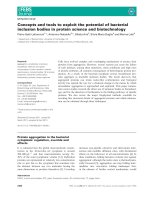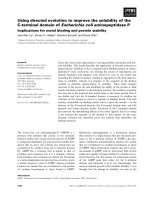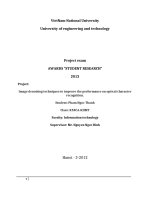Some highligh problems on current status and recommendation to improve the performance of material sciences research institutes in Vietnam
Bạn đang xem bản rút gọn của tài liệu. Xem và tải ngay bản đầy đủ của tài liệu tại đây (260.27 KB, 8 trang )
80
SOME HIGHLIGH PROBLEMS ON CURRENT STATUS
AND RECOMMENDATION TO IMPROVE THE PERFORMANCE
OF MATERIAL SCIENCES RESEARCH INSTITUTES IN VIETNAM
Tran Hau Ngoc, Pham Xuan Thao1, Nguyen Thi Ha, Nguyen Ngoc Chien
Vietnam Center for Science and Technology Evaluation, MOST
Nguyen Thi Thu Oanh
FIRST Project Office, MOST
Abstract:
This paper will provide a brief summary of some important findings, problems to be
adjusted and some recommendations to improve the performance by research and
development (R&D) institutes in the field of materials science (MS) in Vietnam based on
analytical and survey data in 2016 by Vietnam Center for Science and Technology
Evaluation. From the review of various data sources, the authors selected the optimal
option to determine the list of R&D organizations in MS field in Vietnam and conduct
surveys at those organizations to collect data whether serving the current status. In
addition to analyzing a number of key operational issues, this report provides some
recommendations for improving the performance of R&D organizations in MS field - one
of priority fields in S&T development strategy 2011-2020 and vision 2030.
Keywords: Current status; R&D organization; Material sciences field.
Code: 17051501
1. Introduction
MS is an interdisciplinary2 S&T field, of particular importance to the
development of modern technology products. In recent decades, not only in
Vietnam but also in most countries, especially in developed countries, MS
is an priority area for development3. Therefore, the development of R&D
organizations in this field is always concerned by Governments. On the
other hand, recently, the Government of Vietnam has issued several
important new policies directly related to the operation of S&T
1
The author’s contact email address:
In the article “Classification of R&D organizations by sector for assessment: case of material sciences in
Vietnam” in Journal of Science and Technology Policy and Management, No. 2, 2015, the author has analyzed the
concept and subject areas, research direction of MS sector.
3
Decision No. 418/QD-TTg dated 11th April, 2012 of the Prime Minister promulgated the S&T Development
Strategy for 2011-2020, in which one of the priority S&T is new material technology- the next product of R&D in
MS sector.
2
81
organizations in general and R&D organizations in particular. Prominent
among these policies are the Prime Minister's Decisions: Decision No.
2245/QD-TTg dated 11th December 2015 approving the Project of
restructuring of S&T sector to 2020 with a vision to 2030 associated with
transferring the growth model to contribute to economic development;
Decision No 171/QD-TTg dated 27th January 2016 approving the planning
of the network of public S&T organizations up to 2020 with orientation to
2030. Among them, one of the main viewpoints is that it is necessary to
plan the network of public S&T organizations in line with the process of
restructuring S&T; To strongly and synchronously renovate the
organization and management mechanism of S&T activities; To concentrate
investment on developing potentials of a number of organizations in the
S&T priority domains so as to reach the regional and world level. It is
therefore important to analyze and evaluate the current status of R&D
activities in S&T fields, which provide the basis for recommending
measures to promote successful restructuring, at the same time, improving
the performance of R&D organizations.
In a recent research (2016), authors analyzed some data sources to define
the list of R&D organizations in MS field in Vietnam and surveyed,
analyzed the current status of operations of these organizations in 20112015 periods. This paper will brief some important finding, problems,
which need to adjust and some recommendation to improve the
performance in R&D organizations in MS field.
2. What is the role of the research and development organizations in
the materials science field?
The question for managers is: Which organizations in Vietnam are
conducting R&D in the MS field?
The problem to be solved first is to look for data sources to give answers to
the above questions. The data sources which can be used to list the R&D
organizations in the MS field including: (i) The list of the Executive Board
members of the Association are representatives from almost organizations
which conduct R&D activities in MS field; (ii) Analysis of the sources of
publications (articles, reports,...). Most R&D organizations in all S&T
fields are requires to make public the outcomes of their research activities at
various levels, in the journals or in the proceedings of national and
international conferences. R&D organizations in Vietnam are taking
advantage of the opportunity to announce research results at major
international conferences held in Vietnam or periodic professional national
conferences. Therefore, analysis of the origin of publications in the
82
proceedings4 of professional conferences in MS field can at least provide a
list of organizations that have studied the field.
The analysis outcomes based on the presence of R&D organizations in MS
field at the workshops match well with the ones based on the list of
Executive Board member of MS Association of Vietnam. This analysis
shows that the majority of R&D organizations in MS sector are in the
university system (mostly in Hanoi and Ho Chi Minh City) - about 65-70%.
Organizations at the research institutes account for less than half of the
universities (about 25-30%) and very few belong to ministries (about 5%).
There are more than 30 organizations focusing on R&D in MS field and
most organizations have been operating for more than 10 years. Many other
organizations also have R&D in the MS field, but they are not focused there are only a few small research groups working in this field.
The authors investigated R&D organizations in MS field with different
aspects of activity, such as resource mobilization and utilization, results
management, organizational governance,… and summary the main issues
that organizations need to improve in order to improve operational efficiency.
3. Issues in the operation of research and development organizations in
the materials sciences field
3.1. The problem of organizational scale
There are many R&D organizations in the MS field, however, most of them
are very small-size organizations and are invested with quite scattered
research funding. Except for a few organizations focusing on MS activities,
such as Institute of Material Science (belong to Vietnam Academy of
Science and Technology - VAST) with about 250 researchers5 and some
other institutions with about 80-100 researchers such as the Institute of
Tropical Technology (VAST), Institute of Chemistry - Materials (under the
Institute of Military Science and Technology), the rest are only about 50
researchers6 down. Among them, 60% organizations have less than 15
researchers, 10% have 15-25 researchers and 30% have 25-50 researchers.
4
Proceeding of scientific conferences were exploited included: National Conference on Solid State Physics and
MS (SPMS): Periodicals (2010, 2011, 2012, 2013, 2014, 2015, 2016); National Spectrum Optical Conferences:
Periodicals (2010, 2011, 2012, 2013, 2014, 2015, 2016); International Workshop on Advanced Materials Science
and Nanotechnology (IWAMSN): Periodicals (2010, 2012, 2014, 2016); International Conference on Advanced
Materials and Nanotechnologies (ICAMN): periodical organization (2012, 2014, 2016); International Symposium
on Frontiers in Materials Science, ISFMS: held in 2010, 2011, 2013, 2015 and 2016; International Workshop on
Nanotechnology and Applications (IWNA): periodic odd years (2009, 2011, 2013, 2015).
5
Source: The number of staff from the Institute of Material Sciences is taken from the Annual Report of Vietnam
Academy of Science and Technology in 2015.
6
According to a survey of R&D organizations of the Vietnam Center for S&T Evaluation in 2015, the number of
researchers in organizations is averaged over the five-year period 2011-2015.
83
Most organizations operate separately, without close coordination in R&D
with each other. In addition, the budget for research (excluding regular
expenses and other funding) is not large: only 40% of organizations have
budgets of more than 3 billion VND/year, 30% of organizations have the
budget about 1 to 3 billion VND and 10% of the organization is less than 1
billion VND. Thus, very few organizations can have the capacity to achieve
significant research results that generate social-economic value (according
to opinion of experts).
3.2. Problem in result management
Most organizations have little experience in intellectual property (IP)
protection. Nearly 90% of the surveyed organizations have prior
orientations (some organizations set priority level 1 and others set level 2)
to applied research with R&D results of this type are new technologies.
However, most organizations do not have IPRs for technological results.
Many organizations have opportunities to develop and commercialize new
valuable products and services. Most organizations recognize the
importance and value of being involved in this process. However, these
organizations recognize that they are lacking of knowledge, skills and
resources needed to carry out this activity. The shortage is: Firstly, lack of
knowledge of the commercial market, research organizations will take time
to understand the technology and products which bring great commercial
value; Secondly, lack of experience in the protection of IP (eg, patents,
property rights, etc.). The process of patenting new technology often
includes evaluating existing inventions and analyzing the market to
determine how to locate a new technology to apply successfully that patent
into market success. Research institutes and universities around the world
have done so well over the years especially in pursuit of international
protection. Thirdly, the transfer of technology or the introduction of new
products to the commercial market will have to go through difficult steps in
issuing licenses to businesses or establishing a start-up business, while they
have very little experience in these areas. Faced with these challenges, these
organizations often ignore opportunities to protect IP against new
technologies and products, and as a result, they will lose the opportunity to
create significant economic value.
3.3. Problem in defining operational model
Most of the applied researches which R&D organizations are implementing
focuses on the application of existing technology systems, sample models
and fabrication. Many applied researches do not offer new technologies,
much of which focuses on the application and creation of products for use
in Vietnam and small-scale production. These organizations focus on
creating value for money, increasing revenue and managing costs rather
84
than research, develop new technologies and advanced technologies.
Although this activity can bring significant financial value to the
organization, but not yet developed new technology has the potential to
commercialize into products and services, organizations can not develop
sustainably, even if they are all likely to be. Although the construction of
new technology systems is likely to protect IPRs which are technical risks,
but at the same time, there are many great opportunities for economic value.
The cause of this problem may be: inexperienced organizations in R&D
orientation, as well as lack of experience in working with other R&D
organizations and in cooperating with the business sector. Many
organizations recognized the importance of building partnerships with
strong businesses and many organizations have made significant progress in
this respect. However, most organizations lack the experience, skills and
resources to maintain these important relationships.
3.4. Problem in organizational governance
R&D organizations in MS do not set the performance targets nor annual
performance evaluation. 100% of the surveyed organizations reported annual
activity reviews, including a review of activities, achievements in the
previous year and directions for the next year, but not yet evaluated of every
aspect of the activity to find out the strengths to be promoted, weaknesses to
overcome and especially no serious, specific plans to overcome weaknesses.
Organizations are well aware of the importance of evaluating, monitoring and
improving performance. This process does not have an effective monitoring
and evaluating programs. Organizations are not focused on the following
processes: (i) Establishing annual goals and once-a-year organizational goals
will reorient activities at all levels of the organization; (ii) Evaluating of the
progress/results at the end of the year according to the objectives; and (iii)
Evaluating of what is needed to improve organizational performance in the
future and decide which actions should be taken to do.
4. Recommendations to improve the performance of organizations
The recommendations made here are aimed at overcoming the issues
identified by the survey of activities of R&D organizations in MS field as
mentioned above. However, the authors also want to express their views on
setting up policies towards capacity development, improving the
performance of R&D organizations in different areas of the S&T
organizations system in general:
4.1. Improve the allocation of public finance
In many countries with the most effective R&D organizations, the majority
of public funding allocated to R&D organizations is simultaneously passed
85
through two evaluation processes. The first is the process of evaluating of
the performance of the organization in the preceding years. The second is
the allocation of these limited funds to organizations through an evaluation
procedure of proposals for funding. These evaluation procedures are carried
out by independent expert panels and ensured objectivity when allocating
funding. Funding allocations based on these two concurrent evaluation
procedures will be a source of excitement for large-scale organizations to
have significant R&D achievements and for small-size organizations to
seek the closely co-ordination with large and mature R&D organizations.
It is clear that the allocation of public funds based on evaluation systems is
effective and brings at least two major benefits: First, the strength of
organizations in terms of productivity and quality of R&D. Investment in
R&D organizations should have a balance between short-term and longterm results; between the different research directions if they have
competitive advantages and prioritize the development capacity for high
value results. In addition, investment should focus on key tasks that are
researches under linked target groups rather than individual targeted
research. This approach will achieve the best results, the highest benefit in
allocating funds when investing in R&D is always risky; Secondly, it is
possible to produce high value results which is protected IP, to create
valuable R&D products and services, to create community values, to train
qualified researchers and engineers, to enable future projects is funded by
the industry and other sectors.
4.2. Efforts to manage results through intellectual property management
Researchers often have limited about intellectual property experience so
they need guidance and support to achieve high value in technology
development, IP protection for technology and commercialize of outputs
which is protected by IP (including patents, copyrights and spin-offs). The
Government plays a very important role in this process by orienting to
create the outputs related to the supply of the industry as well as reducing
the financial burden of IP protection in abroad for both R&D organizations
and businesses. The Government can also help by reducing the cost of IP
protection, at the same time funding development at an early stage, or
offering incentives to motivate businesses to grow their businesses on the
basis of commercialization of R&D results are protected by IP.
4.3. Enhance the interaction between research and development
organizations and the industry sector
This is very important object to develop the R&D organizations in Vietnam.
R&D organization-industry interaction has many different benefits. One of
the primary benefits is the ability to gain a clearer understanding of the
86
issues that businesses need, to set goals to access funding that helps
improve R&D, and identify the optimal way to commercialize high value
researched IP research results. Therefore, the Government should
immediately implement separate policies and programs to build
relationships between R&D organizations and the industry sector.
4.4. Improve governance through operational structure
The organizational structure of an organization is made up of strategic
objectives and operational models that reflect the organization's core
functions to achieve critical outcomes such as strategic objectives. While
organizational governance is the task of setting up a specific activity plan to
achieve the goal. This specific plan contains the mission, vision, goals,
strategic objectives, performance (for annual and 5 years plan), R&D plan,
strategic investment plan and annual performance. Thus, improvement of
certain organizational governance must be through the operational structure,
especially the specific plan. The plan should describe the requirements for
infrastructure, laboratories. This includes the status quo, the plan to
innovate, the organizing and managing the operation system as the
laboratories management and operation, development of human resources,
financial resources and technology information systems, security system,
administration system and other necessary investment. Every year, the
organization should follow this plan to work and the annual performance
assessment should be done according to the goals stated in the plan.
4.5. Organizations need to be systematically assessed on the basis of
international standards
A process of assessing organizations should be designed and implemented
to acknowledge their performance. This is important to account for the
success of organizations. And for the organizations themselves, to
recognize the results achieved, thereby identifying the issues that need
improvement in their activities.
The result of the organization's performance assessment is a document that
provides information about the annual performance of organizations to
achieve the organization's strategic goals and overall strengths. This is
measured by criteria, indicators of success in the implementation of the
proposed plan, as well as other measurements indicating the effectiveness
of overall management.
Performance evaluation is an opportunity for organizations to continually
improve their own management and to provide data for the Government to
evaluate of the governance of R&D organizations. R&D organizations need
to conduct annual self-evaluation and, on that basis, the Government will
review the assessment every 2, 3 or 5 years.
87
5. Conclusion
This paper reviewed prominent issues in R&D activities of R&D
organizations in MS field and took the authors views on recommendations
for activities to address the issues, to improve the performance of
organizations. Key points are: (i) The investment in R&D should be based
on the performance of the organizations and stimulate linkage of R&D
tasks, encourage R&D organizations to link together in an appropriate way
to bring high-value results; (ii) Opportunities should be created for R&D
results to be protected for IP and opportunities to commercialize high-value
results which are protected by IP to overcome shortcomings in managing
their activities; (iii) The Government should create opportunities and R&D
organizations should also actively enhance their interactions with
enterprises to link industry needs with R&D activities for R&D
organizations to identify right operational models, achieve strategic goals
and improve governance through operational structure based on detailed
plans of established requirements. This aims at overcoming the existence of
a kind of operation as business on the basis of economic contracts to
improve the existing technologies in accordance with Vietnamese
conditions or to model and create prototype rather than focus on
researching and developing new technology, advanced technology; and (iv)
R&D organizations should be systematically assessed by international
standards to provide the basis data for identifying the achieved results and
the issues that need for improvement of performance.
The consultants and the authors of this paper agree that the operational
issues of R&D organizations in MS field as analyzed in this paper are also a
common problems of many R&D organizations in other S&T fields.
Therefore, the above recommendations are also worth representing to
contribute more basis and facts for managers to further improve S&T
development policies in Vietnam./.
REFERENCES
1.
Decision No. 418/QD-TTg dated 11th April 2012 of Prime Minister on approving the
S&T development strategy in 2011-2020 period.
2.
Vienam Academy of S&T (VAST). Performance report of 2015.
3.
Vietnam Center for Science and Technology Evaluation. 2016. Report on current status
of activities of R&D organizations in MS sector in Vietnam in period 2011-2015.
4.
Pham Xuan Thao. 2015. “Classification of R&D organizations by sectors for
assessment: case of material sciences field in Vietnam”. Journal Science and
Technology Policy and Management, No. 2, 2015, page 33-46.









